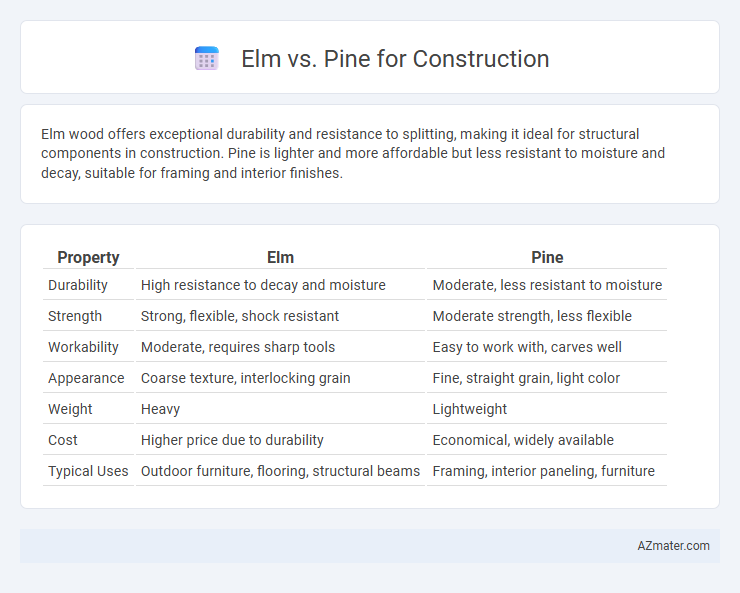Elm wood offers exceptional durability and resistance to splitting, making it ideal for structural components in construction. Pine is lighter and more affordable but less resistant to moisture and decay, suitable for framing and interior finishes.
Table of Comparison
| Property | Elm | Pine |
|---|---|---|
| Durability | High resistance to decay and moisture | Moderate, less resistant to moisture |
| Strength | Strong, flexible, shock resistant | Moderate strength, less flexible |
| Workability | Moderate, requires sharp tools | Easy to work with, carves well |
| Appearance | Coarse texture, interlocking grain | Fine, straight grain, light color |
| Weight | Heavy | Lightweight |
| Cost | Higher price due to durability | Economical, widely available |
| Typical Uses | Outdoor furniture, flooring, structural beams | Framing, interior paneling, furniture |
Introduction to Elm and Pine in Construction
Elm wood is renowned in construction for its exceptional durability, resistance to splitting, and strong interlocking grain structure, making it ideal for furniture, flooring, and boatbuilding. Pine, widely favored for its availability, ease of workability, and cost efficiency, is commonly used in framing, paneling, and interior finishes. Both woods offer specific advantages in construction, with elm providing superior strength and resilience, while pine excels in versatility and affordability.
Physical Properties: Elm vs Pine
Elm wood exhibits superior strength and exceptional resistance to splitting, making it ideal for heavy construction and curved structures. Pine is lighter and more flexible but less dense, providing ease of handling and faster installation in framing and interior works. Elm's high shock resistance contrasts with Pine's softer texture, influencing durability and wear in construction applications.
Durability and Longevity Comparison
Elm wood exhibits superior durability in construction due to its high resistance to moisture and decay, making it ideal for outdoor and structural applications. Pine, while more affordable and easier to work with, tends to be less resistant to rot and insect damage, which can reduce its longevity in harsh environments. For projects demanding long-term strength and resilience, elm offers a more durable and lasting solution compared to pine.
Workability and Ease of Use
Elm offers superior workability in construction due to its interlocking grain that resists splitting, making it ideal for applications requiring strength and durability such as flooring and furniture. Pine, being a softwood with a straight grain, provides excellent ease of use, allowing for faster cutting, shaping, and nailing, which benefits framing and interior paneling projects. Pine's lightweight nature further enhances handling and transportation efficiency, while elm's density poses more challenges but rewards with long-lasting structural integrity.
Cost Analysis: Elm vs Pine
Elm wood generally carries a higher cost compared to pine due to its durability and resistance to splitting, making it suitable for heavy-duty construction projects. Pine is more affordable and widely available, offering cost-effectiveness for large-scale builds but requiring more maintenance over time. When balancing budget and long-term structural integrity, pine serves well for budget-conscious projects, while elm justifies its premium price in applications demanding greater strength and longevity.
Environmental Impact and Sustainability
Elm wood offers high durability with a lower carbon footprint due to its slower growth in temperate climates, making it a sustainable choice for construction projects focused on longevity. Pine grows faster, allowing for quicker replenishment, but often requires chemical treatments that can impact environmental health. Choosing elm supports reduced deforestation rates and carbon sequestration, whereas pine's rapid renewability benefits shorter-term construction needs with manageable sustainability considerations.
Applications in Residential Construction
Elm wood excels in residential construction for its exceptional durability and resistance to splitting, making it ideal for structural components like flooring, beams, and furniture. Pine is widely favored for its softness, ease of workability, and cost-effectiveness, frequently used in framing, paneling, and decorative trim. Both woods offer distinct advantages, with elm preferred for load-bearing applications and pine chosen for versatility and aesthetics in interior finishes.
Resistance to Pests and Decay
Elm wood offers moderate resistance to pests and decay due to its dense grain structure and natural oils that deter insects. Pine, while widely used in construction, generally requires chemical treatment to enhance its resistance to pests and decay, as it is more susceptible to termite and fungal attacks. Choosing elm can reduce maintenance costs and increase the longevity of structures in pest-prone or humid environments.
Aesthetic Differences and Finishing Options
Elm offers a rich, swirling grain pattern with deep, warm tones that enhance rustic and traditional construction aesthetics, making it ideal for exposed beams and decorative paneling. Pine features a lighter, more uniform appearance with distinct knots and a pale yellow hue, lending itself to a bright, casual look suitable for modern and country-style interiors. Finishing options for Elm often include staining and oiling to highlight its complex grain, whereas Pine is commonly painted or varnished to protect its softer surface and emphasize its natural knots.
Conclusion: Choosing Between Elm and Pine
Elm offers superior durability and resistance to moisture, making it ideal for outdoor and heavy-duty construction projects requiring long-lasting structural integrity. Pine is more cost-effective, lightweight, and easier to work with, suitable for interior framing and decorative applications where budget and ease of handling are priorities. Selecting between elm and pine depends on balancing project requirements for strength, exposure conditions, and budget constraints within construction contexts.

Infographic: Elm vs Pine for Construction
 azmater.com
azmater.com